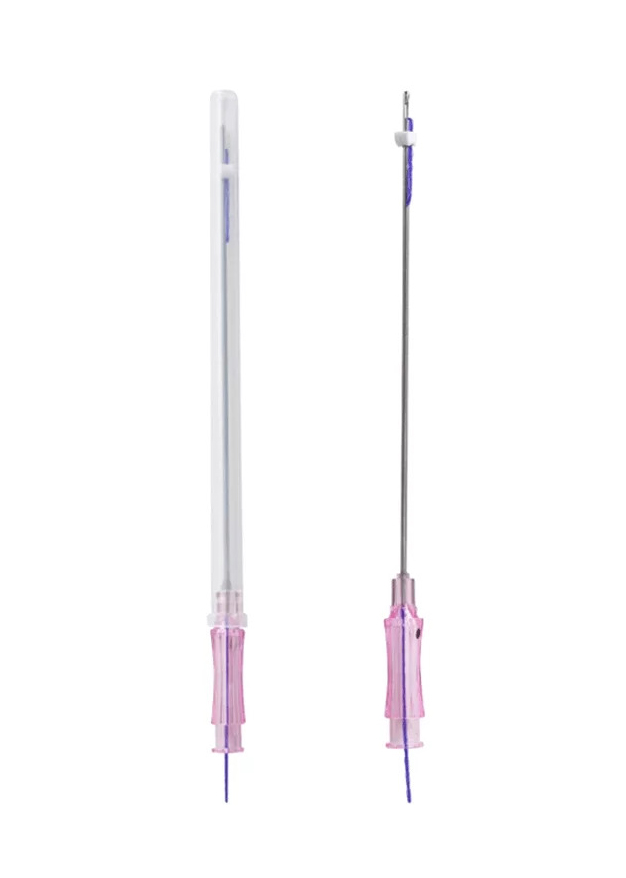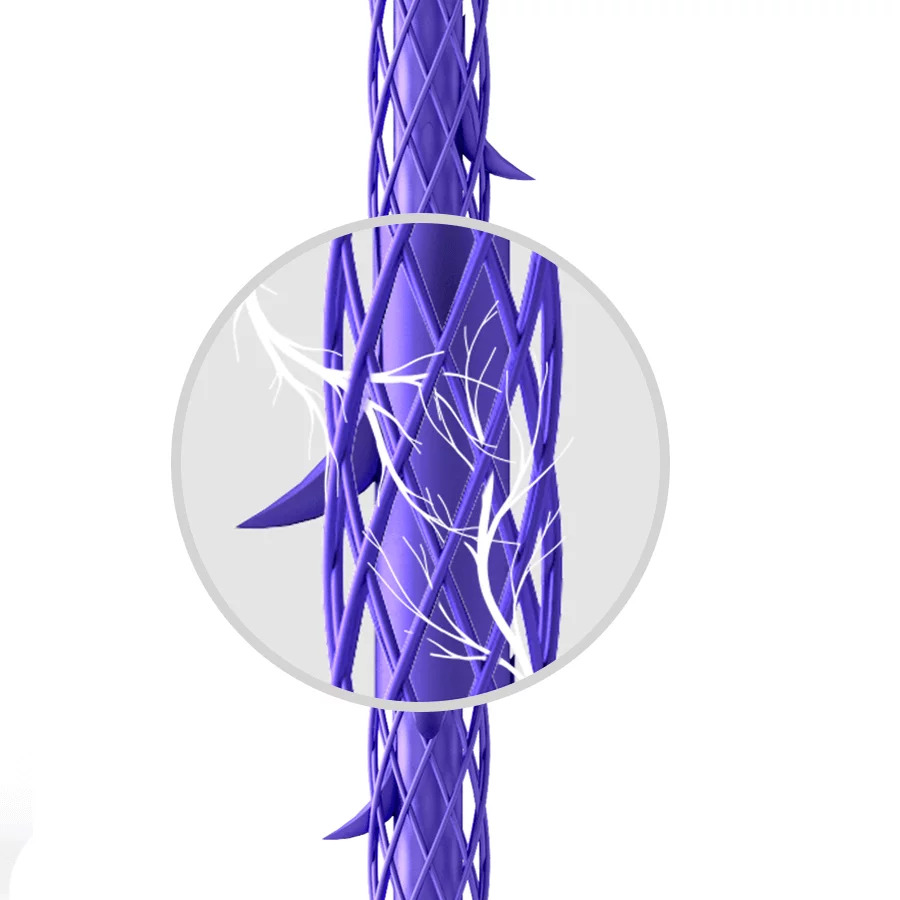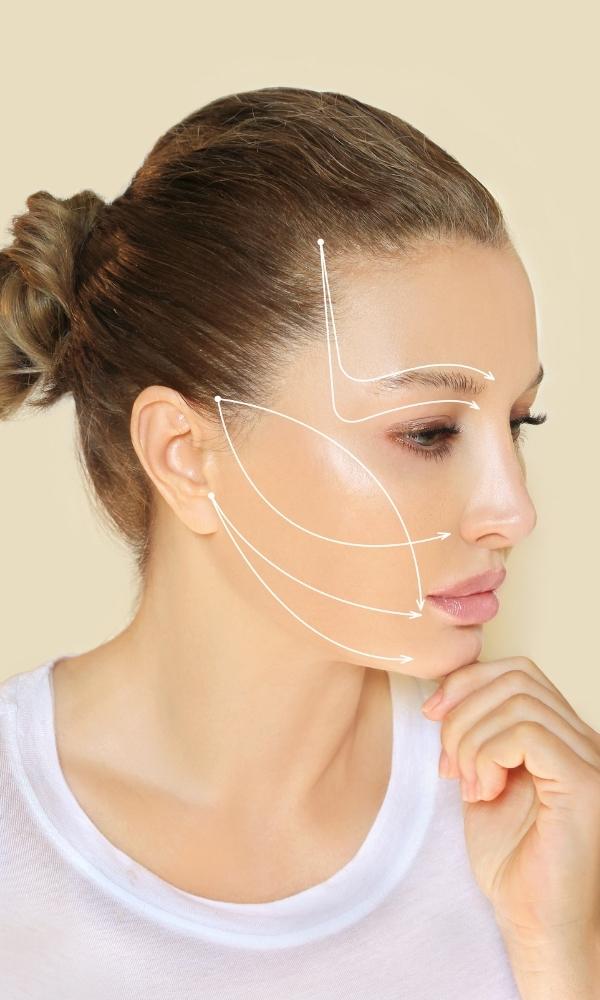TessLift
Metoda liftingu i uniesienia tkanek twarzy i podbródka.

Tesslift – what is it?
Jest to system implantów liftingujących wykonany z biokompatybilnego z ludzkimi tkankami rozpuszczalnego polidioksanonu. Jest to metoda liftingu i uniesienia tkanek twarzy i podbródka. Tesslift to połączenie nici i siatki (ang. mesh). Są to tzw. implanty Mesh – technologia rusztowań siatkowych 3D, opatentowana jako Tesslift Soft (Tissue Elevation Suspension System). Opiera się na ażurowej, specjalnie zaprojektowanej siatce z PDO – z nicią jako rdzeniem implantu wyposażoną w zaczepy oraz z włóknami o zaawansowanej strukturze.
Trzon implantu dzięki posiadanym zaczepom zakotwicza implant we właściwej pozycji, a otaczająca go siatka bardzo szybko wbudowuje się w tkankę własną pobudzając produkcję kolagenu i elastyny oraz syntezę endogennego kwasu hialuronowego. Dzięki temu Tesslift zapewnia natychmiastowy efekt liftingujący, przyleganie do tkanek oraz wytrzymałość na rozciąganie – aż 80 razy większą od konwencjonalnych nici! Co to oznacza dla pacjenta?
Przede wszystkim natychmiastowy i silny, a jednocześnie naturalny efekt liftingu twarzy. Zabieg jest trwa ok. 60 minut, nie wymaga długiej rekonwalescencji, a efekt utrzymuje się nawet 2-3 lata.
Get to know the procedure better
The procedure is primarily performed to lift the midface, improve the jawline, lift the eyebrows (achieving the so-called foxy eyes effect), correct the shape of the nose and lift the neck.
- loss of firmness, flabbiness of the skin,
- tissue drooping, sagging cheeks, jawline abnormality,
- deep wrinkles, especially nasolabial furrows, marionette lines,
- chin furrow, sagging chin,
- neck flaccidity, neck wrinkles,
- drooping eyebrows,
- drooping nose tip, nasal asymmetry.
Thread implantation is a one-time procedure. Repeating the procedure is usually recommended after at least 2 and sometimes even 3 years.
The Tesslift system provides an immediate lifting effect after the procedure, pulling up tissues and smoothing wrinkles (resulting from mechanical tension of tissues). However, since PDO stimulates collagen and elastin production in the skin, natural skin firming and thickening will develop and intensify in the months to come. This process begins about 10-14 days after the procedure and lasts 3-6 months. As a result, you can count on:
- reduction of wrinkles and deep furrows,
- face shape rejuvenation,
- elevating the sagging cheeks and aligning the jawline,
- brow lift, “opening” the eye,
- lifting the drooping mouth corners,
- natural lift of the entire face, lift of tissues, improving skin firmness,
- a more cheerful and younger looking face,
- neck rejuvenation,
- elevation of the nose tip that droops with age, correction of nasal asymmetry.

Duration of the procedure
Find out more
The treatment lasts from about 60 to 90 minutes.
Pain intensity
Find out more
The procedure is performed under dual anaesthesia (external anaesthetic cream and subcutaneous lidocaine with epinephrine), making it virtually painless.
Recovery
Find out more
The insertion of the implants under the skin is similar to the 4d/8d Barb lift threads. They are inserted through pinpoint holes, and the procedure is minimally invasive. After the procedure, the skin may be slightly swollen and red, and small bruises may appear at the insertion sites. Usually, you will be able to return to daily activities the very next day – and conceal the visible marks with makeup (preferably mineral).
How is the procedure?
- First, the treatment planning – Dr Jerschina carefully analyses the indications while taking into account anatomical conditions and facial proportions. The idea is to make the result as natural and harmonious as possible.
- This is followed by dual local anaesthesia – superficial and subcutaneous, which ensures that the procedure is painless.
- The Tesslift system is implanted with a special hollow needle, through pinpoint holes (usually it is 2/6 points per side of the face, done in areas that are not very visible, such as the sides of the cheeks, near the ears, at the hairline).
- The threads are inserted using an innovative zigzag technique – the triple parallel arrangement of the 3D meshes increases the strength of their attachment and resistance to gravity.
- Finally, the face is washed with a disinfectant and the doctor applies dressing plasters to the injection sites.
How to get ready for the procedure?
The procedure does not require special preparations, but it is worth following a few recommendations:
- at least 7 days before the procedure, avoid taking anti-inflammatories that can reduce blood clotting (such as the popular Aspirin), as they can increase the risk of bruises and haematomas after the injection,
- do not consume coffee or alcohol on the day of the procedure,
- if you are prone to herpes, it is a good idea to use a protective drug with acyclovir for 3 days before the procedure (and 3-5 days thereafter).


„Uniesienie tkanek i efekt liftingu jest obserwowany już w trakcie wykonywania zabiegu.”
Dr Barbara Jerschina

TessLift - recommendations after the procedure
After the procedure, there may be mild swelling and redness of the skin, and sometimes small bruises may appear at the thread insertion sites. These symptoms should resolve spontaneously within 1-3 days. During this time, several important recommendations must be followed to avoid complications:
- the insertion points are protected with a special plaster, known as a strip, and during the first few days after the procedure, it is very important to take care of the hygiene of these areas. Do not touch them with your hands, do not wipe it with a used towel, avoid cuddling with pets, change the pillowcase you sleep on to a clean one, etc.
- from the day after the procedure, you can start using post-treatment creams that speed up the healing process of the skin and absorption of bruises and haematomas,
- usually you can apply makeup (preferably mineral makeup, always with a clean brush) the very next day after the procedure.
For proper healing and integration of the threads into the tissues, the first two weeks after the procedure are particularly important. During this time:
- try to avoid opening your mouth wide, refrain from visiting the dentist,
- do not undergo other facial treatments, massages, etc,
- sleep on your back, so as not to put pressure on the skin at the site of thread implantation,
- protect your skin from the sun and heat, do not use saunas or warming treatments.
Call and make an appointment!
FAQ – frequently asked questions about Tesslift
Tesslift gives a spectacular effect of rejuvenating the entire face. However, it is worth combining it with skin refreshing, cleansing and conditioning treatments such as Silk Peel, Aquapure, Hydrafacial or Geneo, as well as other corrective and regenerative methods, depending on the needs and indications. Come in for a consultation with Dr Barbara Jerschina, who specialises in personalised planning of anti-ageing programmes.
Only in the first few days after treatment. After about 2 weeks, you should no longer feel any discomfort. Well-applied threads (the Tesslift implant system) do not pull, do not move, do not come out through the skin, are invisible and undetectable, and do not restrict facial expressions.
Yes, they are made of polydioxanone – a safe substance that is biocompatible with tissues and has been used for many years in various medical fields. It is a material that is absorbed in the tissues gradually over about 12-16 months. During all this time, the threads “work” by stimulating fibroblasts to produce collagen and elastin. As a result, the lift effect lasts for up to 2-3 years.
Przede wszystkim budową (tzw. siatkową), która wpływa na ich wytrzymałość w tkankach. Dzięki temu możliwe jest uzyskanie mocnego, ale jednocześnie bardzo naturalnego efektu, potrzeba mniej nitek, zabieg jest krótki, a rekonwalescencja minimalna.
Most adverse effects are temporary – mainly mild swelling, sometimes minor bruising at the injection site. However, the procedure is minimally invasive and traumatising to the tissues, so most patients can return to daily activities the very next day.
- Pregnancy and breastfeeding
- Inflammation of the skin at the treatment site
- Active herpes
- Cancer diseases
- Unregulated autoimmune diseases
- Advanced diabetes
- Keloid scar tendencies
- Disorders of blood coagulation, taking anticoagulants
- Allergy to the substance from which the threads are made